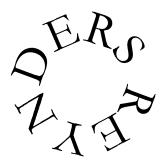

|
|
|
|
CASCARAS & KATASby: James VanDenAkker "My heritage is the heritage of all humanity. The country of my ancestors is the planet Earth. I ain't no minority. I'm part of the human race." Jim In the Cuban repertoire, certain rhythms are divided into the classifications claves and cascaras. The Haitians have a further division called katas. The distinguishing difference between these classes of rhythms are their densities. Classification by density helps by grouping all rhythms of a certain density level together. Once grouped together, they are much easier to explore for similarities and differences. For instance, there are 65,535 possible 16/8 rhythms, not counting strange accentuations, etc. Clearly too extensive a list to explore if one is just trying to find a new bell line. Fortunately, these rhythms can be divided into subgroups by their density, what percentage of the measure the notes occupy. A further filtering out can be accomplished by only including those rhythms that spread themselves evenly across the measure. This is easy to do with a computer, but we don't all have one as part of our "kit". Here is how the classification scenario works. (This will address the 16/8's only. The definitions fit the 8/8's, 6/8's and 12/8's but there are fewer of them). CLAVES: 25% to 50% of the measure. No more than one note in a row. No more than 3 rests in a row. At the 25% level, this would be the minimum of 4 evenly spaced notes, in other words, the typical quadruple 16/8 beat. At the 50% level you would have every other note being played and this is the border of the cascaras. Rhythms with more than 3 rests in a row would have less continuity than the beat. The use of such rhythms as one hand stick rhythms has not been found in any culture. Rhythms with more than one note in a row do not have the distinctive character of a clave. CASCARAS: 50% to 75% density. No more than 2 notes in a row. No more than one rest in a row. The restriction on notes in a row has to do with human dexterity. Rhythms that cover more than half the measure call for speed. If you search the world for cascaras, you will find 99% of them being played with one hand. In most cultures, if a rhythm takes two hands to play, it eventually winds up being played on a drum. (And these classifications are not about drum rhythms). These rhythms are clearly too fast and dense to be thought of as clave rhythms. The division is for the brisk rhythms that humans play on bells, beer bottles and ride cymbals with one hand. It is not that they cannot be played with two sticks. It's just a special division to encompass what most cultures are really doing. Whey playing briskly with one hand, two things become evident. People don't count any rests or leave room for more than one at that speed. It's a natural phenomena found in all cultures. The brain gets occupied with powering the rhythm along and just won't pause to include multiple rests. On the other hand, humans cannot execute three strokes in a row with one hand comfortably. One or two strokes is easy. On a third stroke, the muscles of the forearm tense up. Not enough bounce and recovery is left in the stick. One hand rhythms with more than three notes in a row have never been found in any long term human culture. KATAS: 75% to 100% density. Katas are found in many cultures but it was the Haitians that made them most popular. Therefore, we use the Haitian term. The most popular kata of all is the 100%. This, of course is just like doing a continuous roll. Many Haitian rhythms are made of very few notes. When played alone, they sound fine, but somehow lack in drive. The kata fills in the background with the pulse of the rhythm. Try playing the Haitian glissade Congo without its kata. It will sound kind of bare, like most of its substance is missing. Add the kata and the rhythm leaps with fire.
16/8 Cascaras Density: 50% to 75% Notes: 8 to 10; no more than 2 in a row Rests: 8 to 6; no more than 1 in a row 1. X-X-X-X-X-X-X-X- 2. XX-X-X-XX-X-X-X- 3. XX-X-XX-X-X-X-X- 4. XX-XX-X-X-X-X-X- 5. XX-XX-X-XX-XX-X- 6. XX-XX-XX-X-XX-X- 7. XX-XX-XX-XX-X-X-
16/8 Katas Density: 75% to 100% Notes: 12 to 16 Rests: 4 to 0; no more than 1 in a row 1. XXX-XXX-XXX-XXX- 2. XXXX-XX-XXX-XXX- 3. XXXX-XX-XXXX-XX- 4. XXXX-XXX-XX-XXX- 5. XXXX-XXX-XXX-XX- 6. XXXX-XXX-XXXX-X- 7. XXXX-XXXX-X-XXX- 8. XXXX-XXXX-XX-XX- 9. XXXX-XXXX-XXX-X- 10. XXXXX-X-XX-XXXX- 11. XXXXX-X-XXX-XXX- 12. XXXXX-X-XXXX-XX- 13. XXXXX-X-XXXXX-X- 14. XXXXX-XX-X-XXXX- 15. XXXXX-XX-XX-XXX- 16. XXXXX-XX-XXX-XX- 17. XXXXX-XX-XXXX-X- 18. XXXXX-XXX-X-XXX- 19. XXXXX-XXX-XX-XX- 20. XXXXX-XXX-XXX-X- 21. XXXXX-XXXX-X-XX- 22. XXXXX-XXXX-XX-X- 23. XXXXX-XXXX-XXXX- 24. XXXXX-XXXXX-X-X- 25. XXXXX-XXXXX-XXX- 26. XXXXXX-X-X-XXXX- 27. XXXXXX-X-XX-XXX- 28. XXXXXX-X-XXX-XX- 29. XXXXXX-X-XXXX-X- 30. XXXXXX-XX-X-XXX- 31. XXXXXX-XX-XX-XX- 32. XXXXXX-XX-XXX-X- 33. XXXXXX-XX-XXX-X- 34. XXXXXX-XXX-X-XX- 35. XXXXXX-XXX-XX-X- 36. XXXXXX-XXX-XXXX- 37. XXXXXX-XXXX-X-X- 38. XXXXXX-XXXX-XXX- 39. XXXXXX-XXXXX-XX- 40. XXXXXX-XXXXXX-X- 41. XXXXXXX-X-X-XXX- 42. XXXXXXX-X-XX-XX--X-XX-XX-43. XXXXXXX-X-XXX-X- 44. XXXXXXX-X-XXXXX- 45. XXXXXXX-XX-X-XX- 46. XXXXXXX-XX-XX-X- 47. XXXXXXX-XX-XXXX- 48. XXXXXXX-XXX-X-X- 49. XXXXXXX-XXX-XXX- 50. XXXXXXX-XXXX-XX- 51. XXXXXXX-XXXXX-X- 52. XXXXXXX-XXXXXXX- 53. XXXXXXXX-X-X-XX- 54. XXXXXXXX-X-XX-X- 55. XXXXXXXX-X-XXXX- 56. XXXXXXXX-XX-X-X- 57. XXXXXXXX-XX-XXX- 58. XXXXXXXX-XXX-XX- 59. XXXXXXXX-XXXX-X- 60. XXXXXXXX-XXXXXX- 61. XXXXXXXXX-X-X-X- 62. XXXXXXXXX-X-XXX- 63. XXXXXXXXX-XX-XX- 64. XXXXXXXXX-XXX-X- 65. XXXXXXXXX-XXXXX- 66. XXXXXXXXXX-X-XX- 67. XXXXXXXXXX-XX-X- 68. XXXXXXXXXX-XXXX- 69. XXXXXXXXXXX-X-X- 70. XXXXXXXXXXX-XXX- 71. XXXXXXXXXXXX-XX- 72. XXXXXXXXXXXXX-X- 73. XXXXXXXXXXXXXXX- 74. XXXXXXXXXXXXXXXX
|